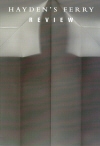december – Winter 2013
After a brief, thirty-two-year interlude between this volume and its last, december is back with its latest anthology-format release. And while many Decembers have passed since the last december, Gianna Jacobson, who takes over editorial and publishing duties from the late Curt Johnson, has made certain that the poetry, prose, and art portfolios in the latest issue possess those timeless qualities which the original editors laid out for the magazine more than a half century ago when they described themselves as “humanists . . . far more concerned with people than we are with dogmatic critical or aesthetic attitudes.” With its unpretentiously elegant layout and the urgency of its content, december’s revival issue feels like a confident extension of this long-standing tradition. Continue reading “december – Winter 2013”

 Printed on the back cover of this issue of Hayden’s Ferry Review appears, along with front and back cover art by Carlos Jiménez Cahua, the word “DEPARTURE” broken into three lines: DEP / ART / URE, and I noticed this one afternoon picking up the issue from the coffee table. I had already become somewhat familiar with the contents of the issue, and my brain reversed the fragments of the word, reading from the bottom up: Your Art Dep(artment).
Printed on the back cover of this issue of Hayden’s Ferry Review appears, along with front and back cover art by Carlos Jiménez Cahua, the word “DEPARTURE” broken into three lines: DEP / ART / URE, and I noticed this one afternoon picking up the issue from the coffee table. I had already become somewhat familiar with the contents of the issue, and my brain reversed the fragments of the word, reading from the bottom up: Your Art Dep(artment).